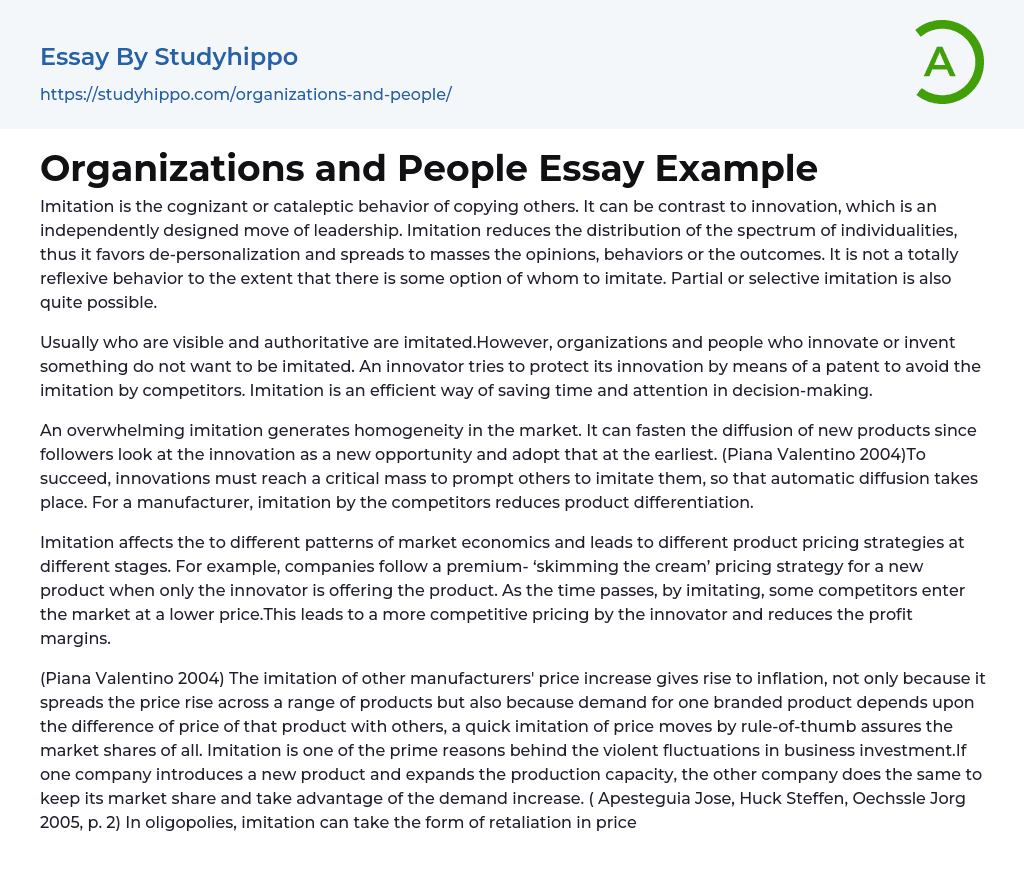Imitation is the conscious or unconscious act of replicating others' behaviors. It can be contrasted with innovation, which involves independent and original leadership actions. Imitation limits the diversity of personalities and promotes depersonalization by disseminating widely held opinions, behaviors, or outcomes to the masses.
Although imitation is not completely reflexive, individuals have the option to choose whom to imitate. Selective imitation occurs frequently, with individuals typically imitating those who are visible and authoritative. However, innovators and organizations that create something new do not desire to be imitated. To safeguard their innovations from competitors, innovators often seek patent protection.
Imitation can save time and attention in decision-making and lead to market homogeneity. It also accelerates the adoption of new products by followers, as they see it as a new opportunity. Innovations need to reach a crit
...ical mass to prompt others to imitate them, facilitating automatic diffusion. However, imitation by competitors can reduce product differentiation for manufacturers. (Piana Valentino 2004)
The act of imitation has an impact on various patterns of market economics and results in different pricing strategies for products at different stages. For instance, when a new product is exclusively offered by the innovator, companies adopt a premium pricing strategy known as 'skimming the cream'. However, over time, competitors enter the market by imitating the product at a lower price. This forces the innovator to adopt more competitive pricing, leading to reduced profit margins. (Piana Valentino 2004) Additionally, imitating price increases by other manufacturers contributes to inflation as it not only spreads the price rise across multiple products but also influences the demand for a branded product based on its price compared to others. By swiftly imitating price
movements, the market shares of all products are assured according to a rule-of-thumb.
The violent fluctuations in business investment often occur due to imitation. When one company introduces a new product and expands its production capacity, other companies in the market respond by doing the same to maintain their market share and capitalize on the increased demand (Apesteguia, Huck, & Oechssle, 2005, p. 2). In oligopolies, imitation can manifest as retaliation during price wars, where there is a realistic probability of opponents imitating each other.
The presence of a dominant market leader and one or more followers who simply adjust their prices allows the leader to establish a monopolistic price, thereby maximizing overall profits. The followers then adopt the same price while focusing on non-price competition and considering cost structures. Certain firms have not specialized in R or innovation, but rather in imitating, inventing around, producing, and marketing products that were often created elsewhere and sold over-the-counter. This group includes companies like Bristol-Myers, Warner-Lambert, Plough, American Home Products, as well as many firms in France, Italy, Spain, and Japan. Importing technology-intensive goods from developed countries presents an opportunity for developing countries to improve their situation by utilizing advanced inputs in production and gaining knowledge through reverse engineering these goods. This enhances their capacity for domestic imitation and technological expertise. Since the early 1990s, several countries such as India, Brazil, and Mexico have shifted from an import-substituting growth model to increased openness and liberalized trade regimes, granting them greater access to foreign technologies and goods. The dissemination of knowledge has played a crucial role in the economic growth of nations worldwide.
Studies have shown that economic integration between similar,
innovating countries leads to a higher overall rate of innovation and growth, as indicated by Rivera-Batiz and Romer (1991 a, b). Diffusion of knowledge through imitation is equally crucial for technological catch-up, as suggested by Vernon (1966), Krugman (1979), Dollar (1986), and Grossman and Helpman (1991 a, b) (Bottazzi et al., 1999, p. 2). Knowledge diffusion occurs through three channels. Firstly, temporal spillovers involve the time it takes for research and development to reveal its innovative output. Therefore, it is important to analyze the stock of existing ideas and the time structure of research and innovating activity. Secondly, sectoral spillovers occur when the level of knowledge in a sector depends on its own research and development investment as well as that in other technologically similar sectors or industries. Lastly, spatial spillovers refer to the possible effects of research and development that might depend on the physical proximity of industries and laboratories.
The concept of knowledge spillover is utilized by Economists to denote the transfer of ideas or information from one inventor to another without compensation, potentially improving the productivity of R efforts. This phenomenon is also known as a knowledge or technological externality.
- Gas prices essays
- American Dream essays
- Barriers To Entry essays
- Capitalism essays
- Central Bank essays
- Compensation essays
- Consumerism essays
- Economic Development essays
- Economic Growth essays
- Economic Inequality essays
- Economic System essays
- Economy essays
- Employment essays
- Export essays
- Finance essays
- Free Trade essays
- Gross Domestic Product essays
- Human Development essays
- Income Inequality essays
- Industry essays
- Inflation essays
- International Business essays
- International Trade essays
- Macroeconomics essays
- Materialism essays
- Max Weber essays
- Microeconomics essays
- Minimum Wage essays
- Monetary Policy essays
- Monopoly essays
- Pricing essays
- Profit essays
- Recession essays
- resources essays
- Taxation essays
- Trade essays
- Unemployment essays
- Warehouse essays
- World economy essays
- Automobile essays
- Bus essays
- Civil engineering essays
- Cycling essays
- Electric Car essays
- Genetic Engineering essays
- Hybrid essays
- Innovation essays
- Internal Combustion Engine essays
- Invention essays
- Mechanical Engineering essays




